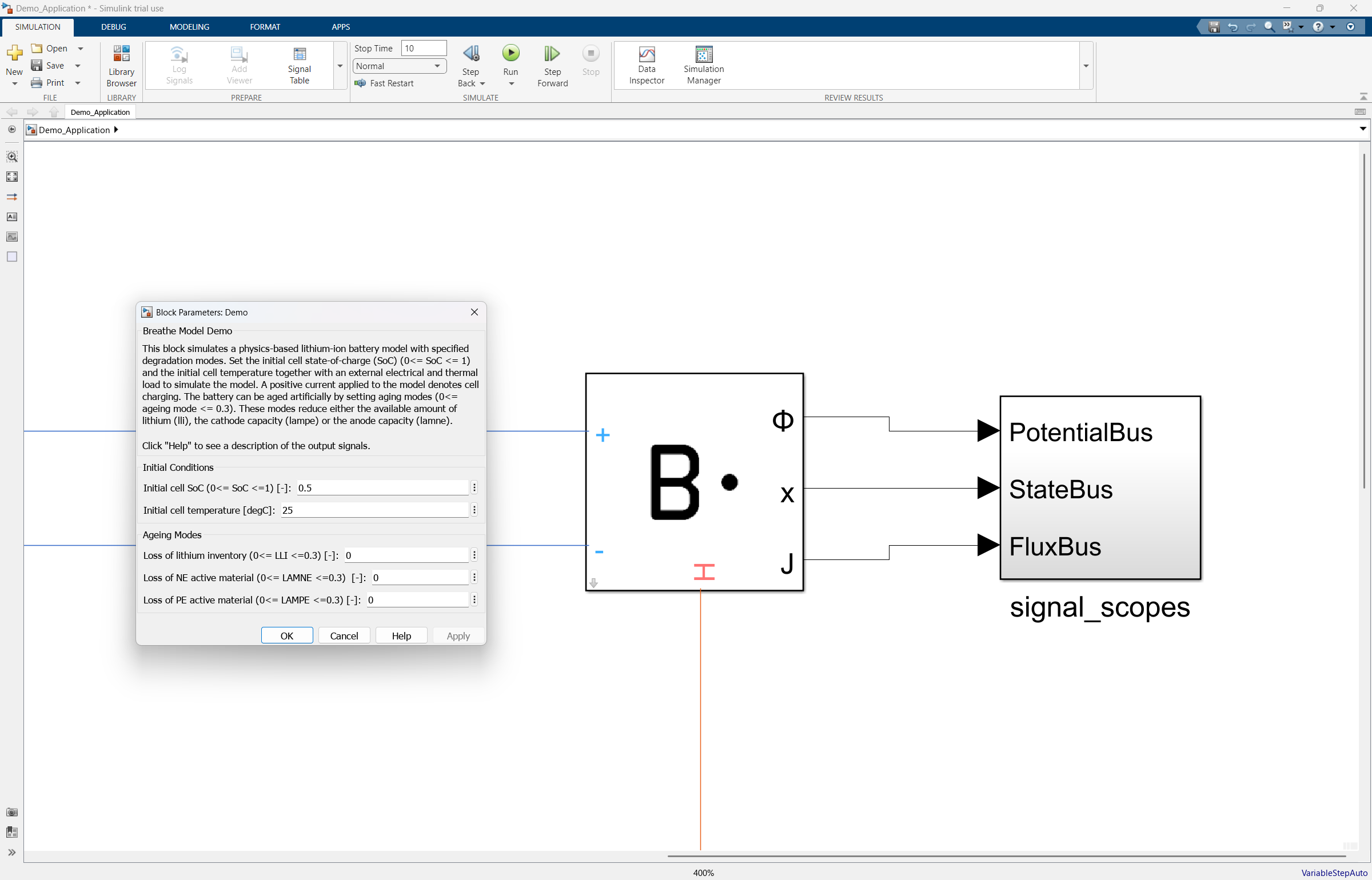
Breathe Model
Answer-first physics-based battery simulation software.
Battery simulation is becoming a competitive advantage.
Today’s battery leaders are building simulation-first development workflows giving them unmatched control over performance, cost, and development speed. For everyone else, simulation remains secondary to expensive physical testing - slow to deploy, hard to trust, and difficult to scale.
Breathe Model changes that. It makes simulation usable from day one: fast to deploy, simple to integrate, and easy to interpret. Whether you're evaluating ageing scenarios, validating thermal limits, or assessing fast charge capabilities, Breathe Model enables you to ask better questions, test more ideas, and iterate faster, with less risk and lower cost.
Answer-first simulation software.
Breathe Model is physics-based battery simulation software that gives engineers fast, accurate answers to system-level questions. Delivered fully parameterised, it enables teams to simulate cell behaviour, test control strategies, and explore system design trade-offs - without building or validating models in-house.
Why Breathe Model?
Physics-based by design.
Breathe Model is built on a physics-based foundation to enable a deeper understanding of battery behaviour and support high-confidence decisions across applications. Our adapted Single Particle Model with Electrolyte (SPMe) architecture captures internal states like lithium concentration, electrode potentials, and heat generation. It balances computational efficiency with physical accuracy and scales across chemistries and formats.
Industrialised, validated, ready to run.
From our 7,500 sq ft lab in London, we deliver high-performance, reproducible models in as little as four weeks. Breathe Model is fully parameterised using our in-house process, delivered with transparent validation reports, and packaged as a ready-to-run MATLAB Simscape block. Our industrialised model development pipeline is built for scale - delivering high-quality models quickly, affordably, and always at the pace expected by the most demanding engineering teams.
Answer-first, not model-first.
Our goal is simple: help engineers get to answers, not just run simulations. Breathe Model includes out-of-the-box support for common modelling environments, full documentation, and a library of pre-configured, use-case specific, worked examples.
Have a complex question you're trying to answer?
Get in touch — our team can help you build a worked example tailored to your specific challenge.
Key features
Validate system performance across degradation states
Breathe Model allows engineers to adjust degradation modes - including loss of lithium inventory (LLI) and active material loss in both electrodes (LAM_NE, LAM_PE) - to simulate aged cell behaviour. This makes it possible to evaluate how systems respond to realistic degradation scenarios such as calendar ageing, high-temperature exposure, extreme user profiles, or manufacturing issues such as anode delamination.
Instead of waiting on time-consuming empirical cycling, engineering teams can validate system performance and optimise control strategies across a wide range of degradation profiles. This dramatically reduces test time and cost, while improving product robustness and safety over life.
Create fast-charge control strategies
Fast charging can accelerate degradation and compromise battery safety if not carefully managed. Breathe Model enables engineers to design and validate charge control strategies that maximise charging speed while protecting battery health.
Using internal states like anode potential, Breathe Model can help teams generate and evaluate charging current profiles without extensive empirical testing. Engineers can quickly build lookup tables (LUTs) that dynamically adjust current by state-of-charge and temperature, enabling implementation on low-power embedded hardware.
Fast charging is inherently complex, influenced by thermal heterogeneity, cell design, manufacturing variability, material limitations, and the need to adapt strategies as cells age. While Breathe Model supports the generation of traditional LUT-based fast charge strategies, Breathe’s adaptive charge control software, Breathe Charge, should be considered for applications that demand the highest level of optimisation.
Design and validate SoX estimators
State-of-charge (SoC) and State-of-health (SoH) estimation are central to battery safety, performance, and product experience - but building robust, accurate estimators is difficult, particularly for newer chemistries. Traditional approaches rely on oversimplified models and costly empirical tuning, making them brittle under real-world conditions.
Breathe Model changes that. It provides an ideal environment for designing, testing, and validating SoX estimators - without hardware in the loop. By simulating battery states under known conditions, Breathe Model acts as a digital twin for tuning estimator performance across use cases and stress scenarios.
Breathe Model is being developed to output pre-tuned, reference estimators directly from the model instance - enabling battery teams to go avoid on-off consultancy projects and go straight to implementation.
Automatically generate Equivalent Circuit Models (ECMs)
ECMs are simplified electrical models of batteries - ideal for fast system-level simulation, control development, or embedding into BMS and HiL setups. But generating ECMs manually is slow, data-heavy, error-prone and often requires time-intensive testing protocol iterations.
Breathe Model automates ECM generation using physics-based simulations - not lab data - to create fast, accurate reduced-order models in minutes. Our approach starts with a validated electrochemical-thermal model and generates synthetic pulse data across SoC, temperature, and C-rate. From this, we automatically fit ECN parameters and generate lookup tables for real-time simulation.
Chemistry agnostic — with dedicated support for LFP
Breathe Model is built on a physics-based foundation that generalises well across a range of cell chemistries. This allows us to adapt quickly to new chemistries, without rebuilding our model pipeline from scratch.
As lithium iron phosphate (LFP) gains traction in the industry, we’ve developed a physics-based LFP model that captures its distinct dynamics - so you’re ready for whatever your roadmap demands.
Try it yourself
Download our free Molicel P45B instance to explore how Breathe Model works in a real-world context.
Get started today
Design, validate and optimise your battery system development to maximise performance, minimise risk and strike the right balance between cost, flexibility and control.
Our adoption process is simple, focused on delivering you results fast.
Demo Breathe Model
Explore a demo model, see example KPI reports and learn what the model has to offer.
Submit your cell to our lab
Select your target cell(s) and share key specifications, including the model operating window.
Model parameterisation
We’ll parameterise your model using our industrialised parameterisation process in as little as 4-weeks.
Receive your model
Receive your model as a Simscape block ready to use in your workflow, with worked examples included.












